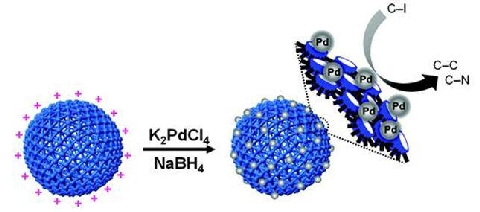An eco-friendly metallic nano particle ? polymer nano capsule for use even in water has been developed. It is anticipated of application to eco-friendly catalyst, bio-imaging and nano medical fields.
Center for Self-assembly and Complexity (Director: Kim Gi-moon) from Institute for Basic Science (IBS) announced on the 19th that it had developed a technology to evenly distribute metallic nano particles on the surface of a polymer nano capsule comprised of ‘cucurbit[6]uril.’
Metallic nano particles have been used in industrial, pharmaceutical and agricultural fields because of its unique features of wide surface area in comparison to volume and surface Plasmon effect. However, it requires the use of toxic liquids, such as toluene and hexane, and thus is associated with such weaknesses as high cost and the cause of poisoning and environmental pollution.
Cucurbituril used by the research team as a carrier has a quality to selectively recognize organic and inorganic chemical species. As a result, it stabilizes and prevents the aggregation of nano particles. Using this, the research team developed the new nano particle ? nano capsule.
This nano capsule maintained stability, dispersibility, catalytic activity and reusability in water rather than toxic solvents. As a result of an experiment, it was found that the nano capsule retained stable state for over six months in water and displayed excellent dispersibility. In addition, it produced 100% reaction to carbon ? carbon and carbon ? nitrogen bonding, and thus showed a high level of catalytic activity.
“Unlike the existing nano particle ? carrier, it produces outstanding properties even in water. So, it provided a new clue to and inspiration for green chemistry,” said Director Kim Gi-moon. “This technology can be applied to eco-friendly catalyst development, bio-imaging and nano medical fields.”
The study outcome was introduced in the online edition of Angewandte Chemie, an international academic journal for chemistry, dated May 19.
※ Cucurbit[6]uril: This is a macrocyclic molecule in the shape of a pumpkin formed by six molecules joined with one another. It was named after the scientific name of pumpkin, ‘Cucurbitaseae.’
Song Joon-yeong | songjy@etnews.com
환경 문제 해결한 나노입자-나노캡슐 개발
<금속 나노입자가 고분자 나노캡슐 표면에 균일하게 도입돼 합성?촉매제 기능을 갖는다.>
물에서도 사용할 수 있는 친환경 금속 나노입자-고분자 나노캡슐이 개발됐다. 친환경 촉매, 생체 이미징, 나노의학 분야에 응용될 것으로 기대된다.
기초과학연구원(IBS) 복잡계 자기조립 연구단(단장 김기문)은 ‘쿠커비투[6]릴’로 이뤄진 고분자 나노캡슐 표면에 금속 나노입자를 균일하게 도입하는 기술을 개발했다고 19일 밝혔다.
금속 나노입자는 부피 대비 넓은 표면적, 표면 플라즈몬 효과 등 고유 특성 때문에 공업, 약학, 농업 분야에서 활용됐으나 톨루엔, 헥산 등 유독성 액체를 용매로 사용해야 했다. 환경오염, 고비용, 중독 등을 유발하는 단점이 있었다.
연구팀이 지지체로 사용한 쿠커비투릴은 선택적으로 유기?무기 화학종을 인지하는 성질을 갖고 있어 금속 나노입자를 뭉치지 않게 안정화할 수 있다. 연구진은 이를 이용해 새로운 금속 나노입자-나노캡슐을 개발했다.
이 나노캡슐은 유독성 용매가 아닌 물속에서 안정성, 분산성, 촉매 활성, 재사용성을 유지했다. 실험결과 물속에서 6개월 이상 안정된 상태를 유지했고 분산성도 뛰어났다. 탄소와 탄소, 탄소와 질소 간 결합에서 100% 반응성을 보이며 우수한 촉매 활성도 보였다.
김기문 단장은 “기존 나노입자-지지체와 달리 물에서도 뛰어난 성질을 보여 녹색 화학 분야에 새로운 단초와 영감을 제공했다”며 “친환경 촉매 개발과 생체 이미징, 나노의학 분야에 응용 가능하다”고 밝혔다.
연구 결과는 화학 분야 국제학술지 ‘앙게반테 케미’ 5월 19일자 온라인판에 소개됐다.
※ 쿠커비투[6]릴 :분자 6개가 모여 만들어진 분자로 호박 모양의 거대 고리 분자다. 호박의 학명 ‘쿠커비타세’를 따서 이름이 지어졌다.
송준영기자 | songjy@etnews.com
